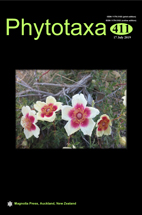Abstract
Pax & Hoffmann (1914) published a new combination, Macaranga kurzii (Kuntze 1891: 620) Pax & Hoffmann (1914: 360) because Tanarius kurzii Kuntze was found to be the earliest replacement name to provide an epithet for the illegitimate name, Macaranga membranacea Kurz (1874: 246) which was described from “Ava, Martaban” in Myanmar. The original material of M. membranacea from the type locality is missing. There is a specimen, collected by Kurz from Myanmar (Pegu, Tookee ridges, Kurz 1549 (CAL0000014004!, K000247051: image!), devoid of flowers and fruits but this sterile collection does not appear to be the type as it was collected from Pegu. It may be mentioned that there is a fruiting specimen of M. kurzii from Yunnan in China collected by D.J. Anderson in 1868 in the Kew herbarium (K001079406) which is identified by Kurz as “Macaranga membranacea Kz” in his own handwriting. There is a duplicate of this collection both at CAL and K. This duplicate was cut vertically into two pieces and the left hand side half was remounted and retained at CAL bearing Kurz’s identification and annotation (“near M. minutiflora Müll., but distinguished at once by large bracts”), while the other right hand side half was sent to Kew by George King for study by J.D. Hooker (J.D. Hooker 1887: 454) and was preserved there. According to Craib (1911: 466), “The specimen collected by Anderson, although not quoted by Kurz in his original description, probably were used by him in his description at least so far as the simple leaves are concerned.” The collection of Anderson agrees well with the protologue of M. membranacea, described on the basis of female plants and bearing identification and annotation by Kurz. We also consider it to be an uncited original material. Hence, this collection is used here to designate lectotype of the name M. membranacea Kurz (1874), non Müller (1866: 996).

